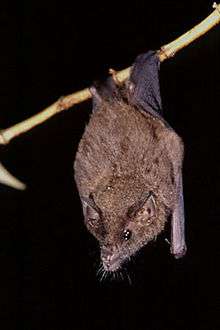Anoura
Anoura is a genus of leaf-nosed bats from Central and South America.[1] Anoura members lack or have a short tail, and are nectarivorous bats of small to medium size among the Phyllostomidae.[2]
| Anoura | |
|---|---|
 | |
| Geoffroy's tailless bat (Anoura geoffroyi) | |
| Scientific classification | |
| Kingdom: | Animalia |
| Phylum: | Chordata |
| Class: | Mammalia |
| Order: | Chiroptera |
| Family: | Phyllostomidae |
| Subfamily: | Glossophaginae |
| Genus: | Anoura Gray, 1838 |
| Species | |
|
Anoura aequatoris | |
| Wikispecies has information related to Anoura |
Etymology
The genus Anoura was described in 1838 by British zoologist John Edward Gray. The type species for the genus was the Geoffroy's tailless bat, Anoura geoffroyi.[3] The etymology of the genus name Anoura corresponds to the two ancient greek words ἀν- (an-), expressing the "absence" (this prefix is an alpha privative), and οὐρά (ourá), meaning "animal tail".[4][5] It refers to the tailless character of these bats.
Note that Anoura, the bat genus, should not be confused with neither 'Anura', an order of amphibians, nor 'Anoures', the original spelling of this order.
Description
Anoura species are small, with head and body lengths ranging from 50–90 mm (2.0–3.5 in). Forearm lengths for the genus are 34–48 mm (1.3–1.9 in). They either totally lack tails or have very short tails of 3–7 mm (0.12–0.28 in). They have elongated snouts, as is seen in Glossophaga bat species. Similar again to Glossophaga, these species have tongues with lingual papillae.[6]
Biology
Anoura species consume nectar, pollen, and insects.[6]
Systematics
- Anoura aequatoris– While a 2006 morphological study suggested elevating Anoura caudifera aequatoris to species level,[7] this conclusion has been challenged. Some believe that it is not distinct enough to warrant separation from A. caudifera, and that further analysis is needed.[8] A 2008 study challenged that elevating it to a species overstated the amount of diversity within the genus, and that it should remain a subspecies.[9]
- Cadena's tailless bat, A. cadenai– The same 2006 study as above split A. cadenai away from A. caudifer.[7] It was challenged by the same 2008 study based on the overall small sample size of the 2006 study, and the small morphological differences between A. caudifer and A. cadenai.[9] A. caudifer has subsequently been considered monotypic by others, disregarding A. cadenai.[10]
- Anoura carishina– This taxa was named and described in 2010 based on morphology, and differentiated a species that had previously been described as Anoura geoffroyi.[11] Principal component analysis of A. carishina and A. geoffroyi have produced conflicting results on whether they describe the same species.[12] Using mixture models, another kind of analysis method, shows that A. carishina and A. geoffroyi are indistinguishable.[8]
- Tailed tailless bat, A. caudifer
- Handley's tailless bat, A. cultrata
- Tube-lipped nectar bat, A. fistulata
- Geoffroy's tailless bat, A. geoffroyi
- Anoura javieri[2]
- Broad-toothed tailless bat, A. latidens
- Luis Manuel's tailless bat, A. luismanueli
- Anoura peruana
References
- Simmons, Nancy B. (2005), "Chiroptera", in Wilson, Don E.; Reeder, DeeAnn M. (eds.), Mammal Species of the World: A Taxonomic and Geographic Reference (3rd ed), Baltimore: Johns Hopkins University Press, pp. 312–529, ISBN 978-0-8018-8221-0, retrieved 13 September 2009
- Pacheco V, Sánchez-Vendizú P, Solari S (2018). "A new species of Anoura Gray, 1838 (Chiroptera: Phyllostomidae) from Peru, with taxonomic and biogeographic comments on species of the Anoura caudifer complex". Acta Chiropterologica. 20 (1): 31–50. doi:10.3161/15081109ACC2018.20.1.002.
- Gray, J. E. (1838). "I.—A Revision of the Genera of Bats (Vespertilionidæ), and the Description of some new Genera and Species". Magazine of Zoology and Botany. 2: 490.
- Bailly, Anatole (1981-01-01). Abrégé du dictionnaire grec français. Paris: Hachette. ISBN 978-2010035289. OCLC 461974285.
- Bailly, Anatole. "Greek-french dictionary online". www.tabularium.be. Retrieved December 9, 2018.
- Nowak, Ronald M.; Pillsbury Walker, Ernest (1999). Walker's Mammals of the World. Volume 1. JHU Press. pp. 373–374. ISBN 9780801857898.
- Mantilla-Meluk, H., & Baker, R. J. (2006). Systematics of small Anoura (Chiroptera: Phyllostomidae) from Colombia, with description of a new species. Museum of Texas Tech University.
- Calderón-Acevedo, C. A., & Muchhala, N. C. Species limits in the Neotropical Bat Genus Anoura Gray. Group, 40, 50.
- Jarrín-V, P., & Kunz, T. H. (2008). Taxonomic history of the genus Anoura (Chiroptera: Phyllostomidae) with insights into the challenges of morphological species delimitation. Acta Chiropterologica, 10(2), 257-269.
- Smith (2012). "Lesser Tailless Bat" (PDF). Mammals of Paraguay. 43. Retrieved May 11, 2017.
- Mantilla-Meluk, H., & Baker, R. J. (2010). New species of Anoura (Chiroptera: Phyllostomidae) from Colombia, with systematic remarks and notes on the distribution of the A. geoffroyi complex. Museum of Texas Tech University.
- Mantilla-Meluk, H., Siles, L., & Aguirre, L. F. (2014). Geographic and ecological amplitude in the nectarivorous bat Anoura fistulata (Pyhllostomidae: Glossophaginae). Caldasia, 36(2), 373-388.
External links
"Anoura". Integrated Taxonomic Information System. Retrieved 7 December 2006.